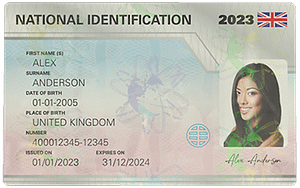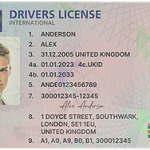Identity is a precious and integral part of our lives. It represents who we are in the digital and physical – worlds, and safeguarding it is of utmost importance. However, the rise of fake ID cards has created a concerning link to the ever – growing problem of identity theft.
Understanding Fake ID Cards
Fake ID cards are counterfeit documents that are designed to mimic legitimate identification. They can range from driver’s licenses, passports, to student IDs. Criminals create these fake IDs for various reasons. One of the most common uses is for underage individuals to gain access to age – restricted places such as bars and clubs. But the implications of fake ID production go far beyond underage drinking.
These fake IDs are often made using advanced printing and laminating techniques. Some criminals even have access to sophisticated equipment that can replicate holograms and other security features found on real IDs. The market for fake IDs has also gone digital, with many websites offering to create and deliver these counterfeit documents for a fee.

The Link to Identity Theft
The connection between fake ID cards and identity theft lies in the information used to create the fake IDs. To make a convincing fake ID, criminals need personal information such as names, dates of birth, addresses, and sometimes even social security numbers. This information is often obtained through identity theft.
Identity theft occurs when someone steals another person’s personal information to commit fraud. Thieves may obtain this information through various means, such as phishing attacks, data breaches, or stealing wallets and purses. Once they have this information, they can use it to create fake ID cards.
For example, if a thief steals a person’s social security number and date of birth, they can use this information to create a fake driver’s license. This fake ID can then be used for illegal activities, such as opening bank accounts, making purchases, or even committing more serious crimes. The victim of the identity theft may not even be aware of the problem until they start experiencing financial or legal issues.
The Consequences of the Risky Connection
The consequences of the connection between fake ID cards and identity theft are far – reaching. For the victims of identity theft, it can lead to financial losses. Thieves may use the stolen identity to take out loans, make credit card purchases, or drain bank accounts. Recovering from these financial losses can be a long and arduous process, often involving working with banks, credit bureaus, and law enforcement agencies.
There are also legal consequences. If a fake ID is used to commit a crime, the person whose identity was stolen may be wrongly accused. Clearing their name can be a complex and time – consuming task, involving court appearances and legal representation.
On a larger scale, the use of fake ID cards and identity theft also undermines the integrity of security systems. It becomes harder for businesses, government agencies, and law enforcement to verify the true identities of individuals, which can lead to security breaches and other issues.
Preventing Identity Theft and the Use of Fake ID Cards
One of the most important steps in preventing identity theft is to be vigilant about protecting personal information. This includes not sharing sensitive information such as social security numbers, credit card numbers, or passwords over unsecured channels. When using the internet, make sure to only visit secure websites, indicated by the “https” in the URL.
Regularly monitoring financial accounts and credit reports is also crucial. By checking bank statements and credit reports frequently, it is possible to spot any suspicious activity early. If any unauthorized transactions or accounts are found, it is important to report them immediately to the relevant financial institution and credit bureau.
For businesses and government agencies, implementing strict identity verification processes can help prevent the use of fake ID cards. This may include using biometric technology such as fingerprint or facial recognition, as well as cross – referencing information with multiple databases.
Law enforcement agencies also play a key role in cracking down on the production and distribution of fake ID cards. By targeting the criminal networks behind fake ID production, they can disrupt the supply chain and reduce the number of fake IDs in circulation.
Common Problems and Solutions
-
Problem: Phishing Attacks
Phishing attacks are a common method used by identity thieves to obtain personal information. They send emails or messages that appear to be from legitimate sources, such as banks or government agencies, asking the recipient to click on a link and provide their personal information. The links often lead to fake websites that are designed to look like the real ones.
Solution: Be extremely cautious when receiving emails or messages asking for personal information. Legitimate organizations will never ask for sensitive information such as passwords or social security numbers via email. Always verify the source of the message by contacting the organization directly using a known phone number or website. Also, look for signs of a phishing email, such as misspelled words, unusual email addresses, and poor grammar.
-
Problem: Data Breaches
Data breaches occur when hackers gain access to a company’s or organization’s database containing personal information. This can include names, addresses, social security numbers, and credit card details. Once the hackers have this information, they can sell it on the dark web or use it for identity theft.
Solution: Companies and organizations should invest in strong cybersecurity measures to protect their databases. This includes using firewalls, encryption, and regular security audits. As an individual, it is important to change passwords regularly, especially after a known data breach has occurred. You can also consider using a password manager to generate and store strong, unique passwords for each of your accounts.
-
Problem: Lost or Stolen Wallets and Purses
When a wallet or purse is lost or stolen, it often contains important identification documents such as driver’s licenses, credit cards, and sometimes social security cards. Thieves can use this information to create fake IDs or commit identity theft.
Solution: Keep only the necessary identification and cards with you. If your wallet or purse is lost or stolen, report it immediately to the relevant authorities and financial institutions. Cancel your credit and debit cards to prevent unauthorized use, and request a replacement for your lost identification documents. You may also want to consider placing a fraud alert on your credit report to make it more difficult for thieves to open new accounts in your name.
-
Problem: Unsecured Public Wi – Fi
Using unsecured public Wi – Fi networks can be risky as hackers can easily intercept the data being transmitted between your device and the network. This includes personal information such as login credentials, credit card numbers, and other sensitive data.
Solution: Avoid using public Wi – Fi for sensitive activities such as online banking or shopping. If you must use public Wi – Fi, consider using a virtual private network (VPN) to encrypt your data. A VPN creates a secure tunnel between your device and the internet, making it much harder for hackers to intercept your information.
-
Problem: Social Media Over – sharing
Many people share a lot of personal information on social media platforms, such as their full name, date of birth, hometown, and even their mother’s maiden name. This information can be used by identity thieves to answer security questions and gain access to your accounts.
Solution: Be careful about what you share on social media. Limit the amount of personal information that is publicly visible on your profiles. Also, review your privacy settings regularly to ensure that only the people you trust can see your personal information. Avoid sharing sensitive information such as your social security number or credit card details on social media altogether.


